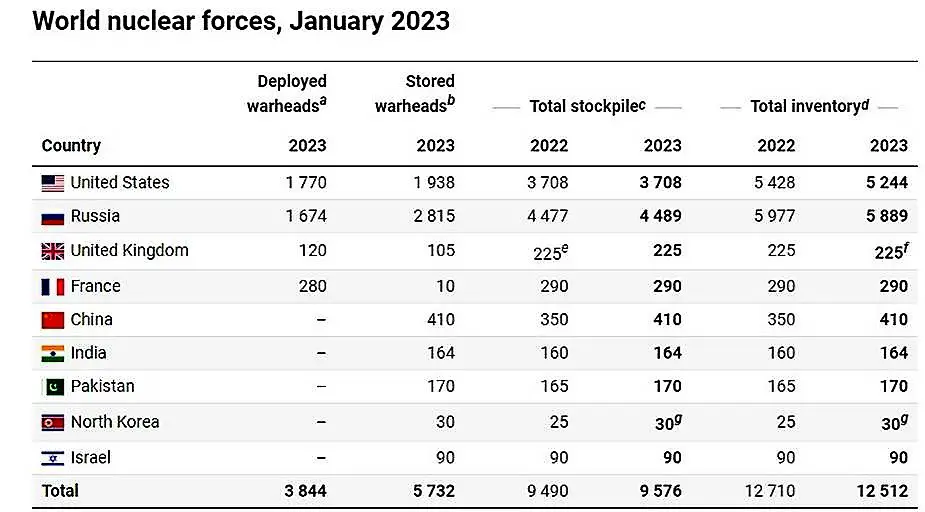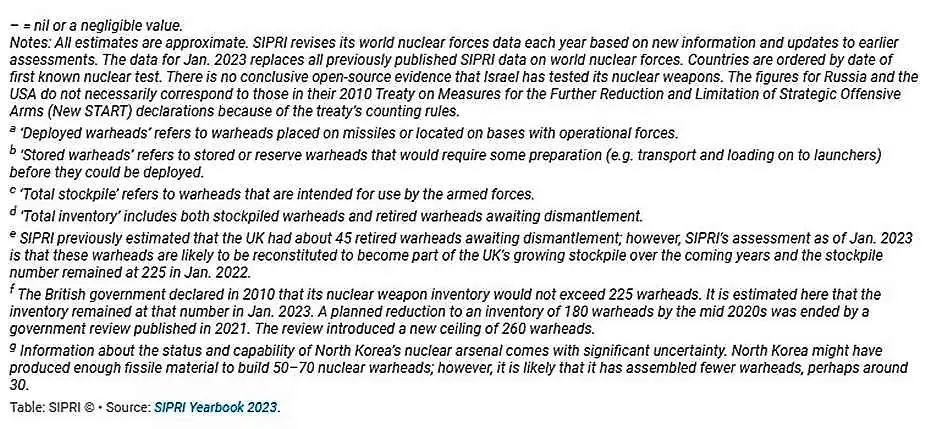Breaking news
SIPRI Yearbook 2023 details how States invest in nuclear arsenals as geopolitical relations deteriorate.
The Stockholm International Peace Research Institute (SIPRI) on June 12 launchee its annual assessment of the state of armaments, disarmament and international security. A key finding of SIPRI Yearbook 2023 is that the number of operational nuclear weapons started to rise as countries’ long-term force modernization and expansion plans progressed.
Follow Army Recognition on Google News at this link

Russian 15U175M TEL RS-24 Yars ICBM (Picture source: Vitaly Kuzmin)
The nine countries possessing nuclear weapons (the United States, Russia, the United Kingdom, France, China, India, Pakistan, North Korea, and Israel) have continued their efforts to modernize their nuclear arsenals. Throughout 2022, several of these states introduced new nuclear-armed or nuclear-capable weapon systems.
As of January 2023, the global inventory of nuclear warheads stood at an estimated 12,512. Approximately 9,576 warheads were kept in military stockpiles, ready for potential use. This number increased by 86 compared to January 2022. Among these warheads, around 3,844 were deployed with missiles and aircraft. Furthermore, roughly 2,000 warheads, primarily belonging to Russia and the USA, remained in a state of high operational alert, meaning they were fitted to missiles or held at airbases with nuclear bombers.
Russia and the USA account for nearly 90 percent of the world's nuclear weapons. The sizes of their respective nuclear arsenals, in terms of useable warheads, remained relatively stable in 2022. However, transparency concerning nuclear forces diminished in both countries following Russia's invasion of Ukraine in February 2022.
Additionally, Russia and the USA each possess over 1,000 decommissioned warheads that are being gradually dismantled.
China's nuclear arsenal saw an increase from 350 warheads in January 2022 to 410 in January 2023, with expectations of further growth. Depending on its force structure decisions, China could potentially possess as many intercontinental ballistic missiles (ICBMs) as the USA or Russia by the end of the decade.
Hans M. Kristensen, an expert from SIPRI, noted that China's nuclear expansion contradicts its stated objective of maintaining a minimum nuclear force for national security purposes.
While the UK did not reportedly increase its nuclear weapons arsenal in 2022, the stockpile of warheads is expected to grow due to the British government's decision to raise the limit from 225 to 260 warheads. Additionally, the UK government announced that it would no longer publicly disclose information about its nuclear weapons quantities, deployed warheads, or deployed missiles.
France continued its programs for developing a third-generation nuclear-powered ballistic missile submarine (SSBN), a new air-launched cruise missile, and refurbishing and upgrading existing systems in 2022.
India and Pakistan showed signs of expanding their nuclear arsenals, introducing and developing new types of nuclear delivery systems. While Pakistan remains the main focus of India's nuclear deterrent, India appears to be placing increasing emphasis on longer-range weapons, including those capable of reaching targets in China.
North Korea continues to prioritize its military nuclear program as a core component of its national security strategy. Although North Korea did not conduct any nuclear test explosions in 2022, it carried out over 90 missile tests. Some of these missiles, including new ICBMs, may have the capacity to carry nuclear warheads. SIPRI estimates that North Korea has assembled around 30 warheads and possesses enough fissile material for a total of 50-70 warheads, representing significant increases compared to January 2022.
Israel, although not publicly acknowledging its possession of nuclear weapons, is believed to be engaged in modernizing its nuclear arsenal.
Matt Korda, an expert from SIPRI, emphasized that most nuclear-armed states are adopting more assertive rhetoric about the importance of nuclear weapons, with some even issuing explicit or implicit threats of potential use. This heightened nuclear competition significantly escalates the risk of nuclear weapons being employed for the first time since World War II.
Wilfred Wan, Director of SIPRI's Weapons of Mass Destruction Programme, expressed concern about the increasing divergence of the five nuclear weapon states recognized by the Nuclear Non-Proliferation Treaty from their commitment to disarmament. He noted that these states are investing billions of dollars in modernizing and, in some cases, expanding their nuclear arsenals.
The situation was further exacerbated by Russia's invasion of Ukraine, which dealt a severe blow to nuclear diplomacy. Following the invasion, the United States suspended its bilateral strategic stability dialogue with Russia. In response, Russia announced the suspension of its participation in the 2010 Treaty on Measures for the Further Reduction and Limitation of Strategic Offensive Arms (New START), the last remaining nuclear arms control treaty between Russia and the US. Talks on a follow-on treaty to New START, which expires in 2026, were also suspended. However, as of January 2023, both countries' deployed strategic nuclear forces remained within the limits of New START, according to SIPRI's assessment.
The political situation in Iran and its military support to Russian forces in Ukraine overshadowed discussions on reviving the Joint Comprehensive Plan of Action (JCPOA), the 2015 agreement aimed at preventing Iran from developing nuclear weapons. The prospects for the revival of the JCPOA now appear increasingly unlikely.
In 2022, both the USA and the UK chose not to disclose information to the public about their nuclear forces, which they had previously done in previous years.
Dan Smith, SIPRI Director, emphasized the urgency of restoring nuclear diplomacy and strengthening international controls on nuclear arms, given the high level of geopolitical tension and mistrust. He highlighted the risks of miscalculation, misunderstanding, or accidents in a period where communication channels between nuclear-armed rivals are either closed or barely functional.
The SIPRI Yearbook's 54th edition reveals the continued deterioration of global security over the past year. The war in Ukraine had wide-ranging impacts on various aspects related to armaments, disarmament, and international security covered in the Yearbook. However, it was not the sole major conflict in 2022, as geopolitical tensions, mistrust, and division had been escalating even before Russia's full-scale invasion of Ukraine.
Dan Smith further warned that humanity is entering one of the most perilous periods in history. Cooperation among governments is imperative to alleviate geopolitical tensions, curb arms races, and address the worsening consequences of environmental degradation and rising global hunger.
In addition to its comprehensive coverage of nuclear arms control, disarmament, and non-proliferation, the SIPRI Yearbook 2023 provides data and analysis on world military expenditure, international arms transfers, arms production, multilateral peace operations, armed conflicts, and more. Special sections in the Yearbook explore topics such as the rise of private military and security companies like the Wagner Group and their impact on peace and security, the governance of space and cyberspace influenced by the war in Ukraine, the implications of attacks on nuclear power plants during the conflict, and the regulation of emerging technologies like autonomous weapon systems.


World nuclear forces as of January 2023 (Picture source: SPRI's Yearbook 2023)
Defense News June 2023























